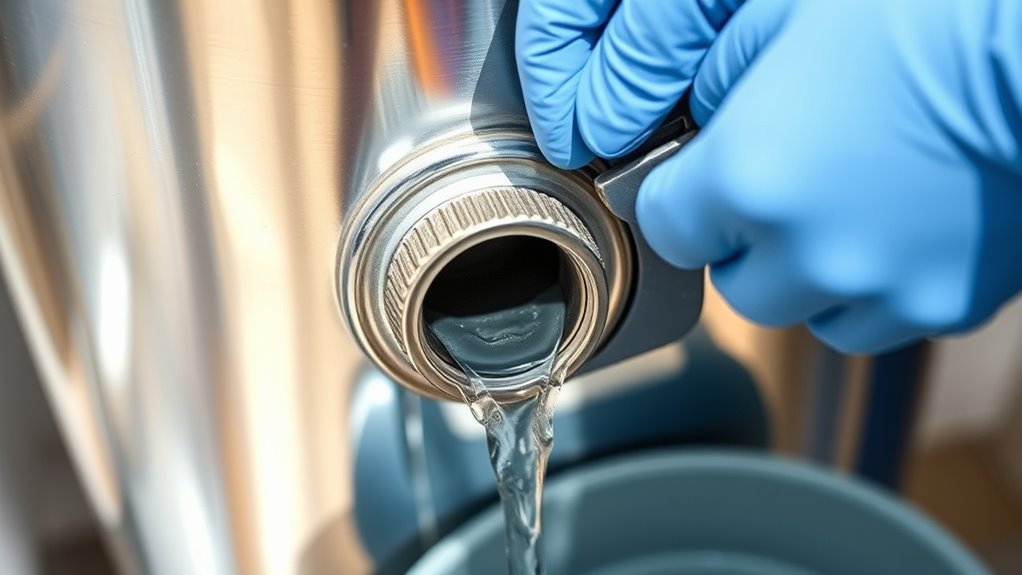To boost your water heater’s lifespan and keep it running efficiently, regularly flush out sediment buildup. Turn off the power or gas, attach a garden hose to the drain valve, and drain the tank to remove deposits. Briefly fill the tank with water to stir remaining sediment, then drain again before refilling and restoring power. Staying on top of these steps helps prevent costly repairs and ensures reliable hot water—learn more to maintain your heater in top shape.
Key Takeaways
- Regularly flush the water heater to remove sediment buildup and maintain efficient heat transfer.
- Turn off power or gas before draining and flushing to ensure safe maintenance.
- Attach a garden hose to the drain valve, open it, and flush out accumulated sediments annually or more often in hard water areas.
- Refill the tank completely after flushing and before restoring power or gas to prevent damage.
- Regular inspection of internal parts and anode rods prolongs the heater’s lifespan and ensures optimal performance.

Regular water heater maintenance is essential to guarantee it runs efficiently and lasts longer. One of the most important steps you can take is performing regular tank maintenance, which keeps the heater functioning at its best and prevents costly repairs down the line. Over time, minerals from your water supply naturally settle at the bottom of the tank, forming sediment that can hinder heat transfer and cause the unit to work harder. This buildup not only reduces energy efficiency but also shortens the lifespan of your water heater. To combat this, sediment removal should be part of your routine maintenance.
Regular maintenance prevents sediment buildup and extends your water heater’s lifespan.
When you flush your water heater, you’re removing that accumulated sediment, which is critical for maintaining the system’s health. Sediment buildup can cause your heater to overheat or develop rust, leading to leaks or other failures. By draining the tank and flushing out the sediment, you clear away these deposits, ensuring the heating elements or burner can operate without obstruction. This process also reduces the strain on the tank’s components, helping you avoid premature replacement. It’s a simple task that can considerably extend your water heater’s life, especially if done annually or more frequently in areas with hard water.
Performing tank maintenance begins with turning off the power or gas supply to the unit. Once the heater is safely shut down, attach a garden hose to the drain valve at the bottom of the tank. Open the valve and allow the water to flow out into a nearby drain or bucket. As the water drains, it will carry with it the sediment that has settled at the bottom. To ensure thorough cleaning, you can briefly turn on the cold water supply to stir up any remaining deposits before shutting off the cold water and letting the tank drain completely. Afterward, close the drain valve, remove the hose, and refill the tank with fresh water. Turning the power or gas back on completes the process. Regularly inspecting anode rods and other internal parts can also help prevent corrosion and extend the lifespan of your water heater.
Regularly performing tank maintenance and sediment removal keeps your water heater operating smoothly. Not only does it help maintain consistent hot water supply, but it also reduces energy costs and prevents breakdowns. Remember, neglecting this maintenance can lead to mineral buildup that diminishes efficiency and damages internal components. Staying proactive with these simple steps ensures your water heater runs reliably for years, saving you money and hassle in the long run.
Frequently Asked Questions
How Often Should I Replace My Water Heater?
You should consider replacing your water heater every 8 to 12 years, depending on its tank lifespan and overall condition. Regularly check for signs of wear, such as leaks, rust, or inconsistent hot water. Following a consistent replacement schedule helps prevent unexpected breakdowns and costly repairs. If your water heater is nearing the 10-year mark or shows signs of aging, it’s time to plan for a replacement to ensure reliable hot water.
Can I Flush My Water Heater Myself?
Yes, you can flush your water heater yourself with proper DIY maintenance and safety precautions. First, turn off the power and cold water supply, then attach a hose to drain it. Be cautious of hot water and sediment. Follow step-by-step guidelines carefully to avoid accidents. Regular flushing helps extend your water heater’s lifespan and improves efficiency, making it a manageable task if you prioritize safety and proper technique.
What Signs Indicate My Water Heater Needs Repair?
Your water heater is like a trusted friend showing signs of fatigue. If you notice inconsistent hot water, strange noises, leaks, or a foul smell, it’s time for repairs. Always follow safety precautions to avoid injury or damage, and remember, ignoring these signs can lead to costly repair costs later. Addressing issues early can save you money and extend your water heater’s lifespan, keeping your home warm and comfortable.
Is a Tankless Water Heater Easier to Maintain?
A tankless water heater is easier to maintain because it has fewer parts prone to sediment buildup and leaks. You mainly need to perform regular tankless maintenance, like flushing it annually to remove mineral deposits. Plus, tankless models offer better energy efficiency since they heat water on demand, reducing energy waste. Overall, you’ll find tankless systems more convenient and cost-effective over time with proper upkeep.
How Can I Prevent Sediment Buildup in My Water Heater?
To prevent sediment buildup and boost your heater’s longevity, you should regularly flush your water heater at least once a year. This process removes accumulated minerals that can cause damage. Additionally, installing a sediment filter can catch debris before it enters the tank. Keep an eye on your water quality, and address any issues promptly. These steps help maintain efficient operation and extend the lifespan of your water heater.
Conclusion
Taking simple steps to care for your water heater can keep it running smoothly and quietly for years to come. Regular flushing and maintenance act like gentle whispers of reassurance, preventing minor issues from blooming into larger problems. Think of it as giving your water heater a invigorating breather, ensuring it continues to serve you comfortably. Show it a little love now, and you’ll enjoy warm, worry-free showers whenever you need them.









